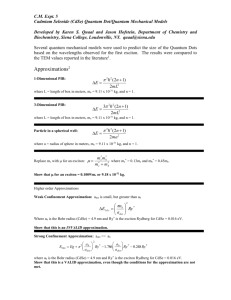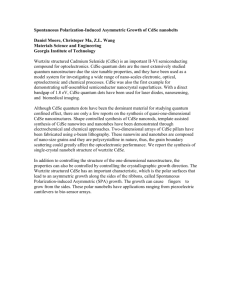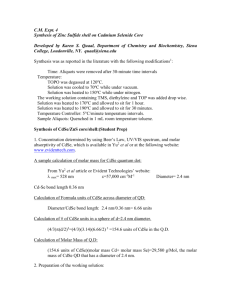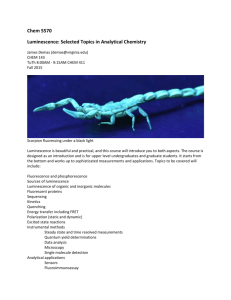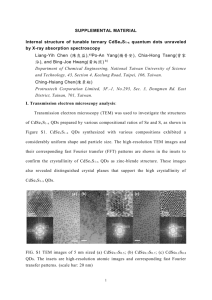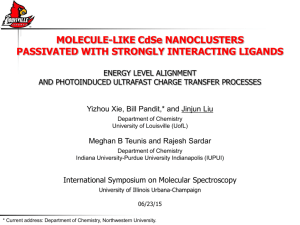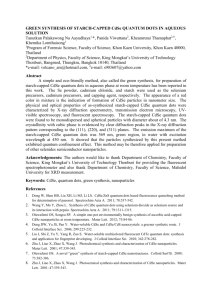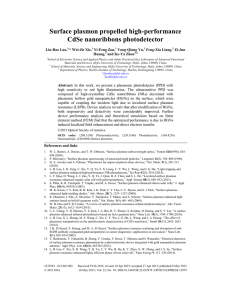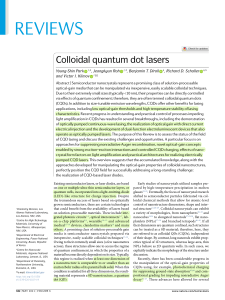ULTRAFAST SPECTROSCOPY OF CHEMICALLY SYNTHESIZED SEMICONDUCTOR NANOPARTICLES M. CHERGUI
advertisement
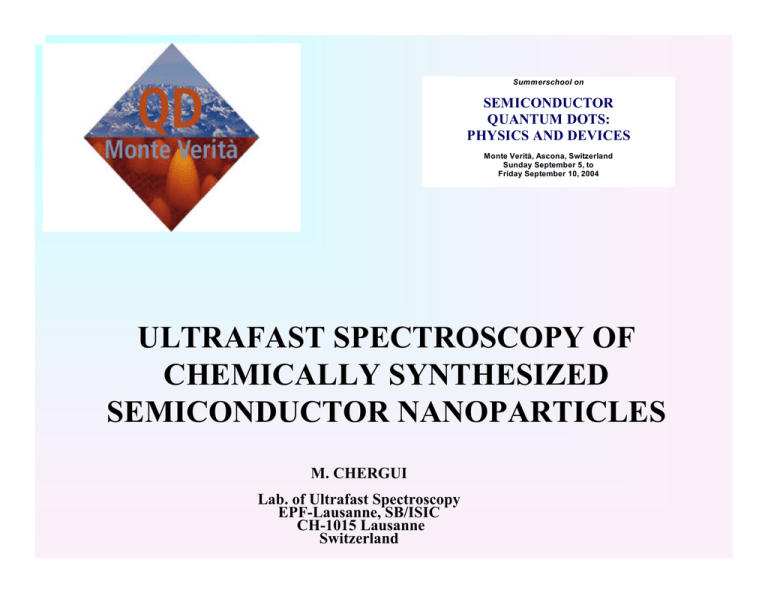
Summerschool on SEMICONDUCTOR QUANTUM DOTS: PHYSICS AND DEVICES Monte Verità, Ascona, Switzerland Sunday September 5, to Friday September 10, 2004 ULTRAFAST SPECTROSCOPY OF CHEMICALLY SYNTHESIZED SEMICONDUCTOR NANOPARTICLES M. CHERGUI Lab. of Ultrafast Spectroscopy EPF-Lausanne, SB/ISIC CH-1015 Lausanne Switzerland Engineerable Optical Properties: CdSe Nanodots size: 2.3 nm λ = 470 nm size: 5.5 nm λ = 620 nm *Murray, C.B.; Norris, D.J.; M. Bawendi, M.G. J. Am. Chem. Soc. 1993, 115, 8706 *Bawendi, M. G. et al. J. Phys. Chem. B 1997, 101, 9463. *Hines, M.A.; Guyot-Sionnest, P. J. Phys. Chem. B. 1996, 100, 468. Some potential applications • Biological tags for imaging (Alivisatos et al) • Electroluminescence from monolayers of CdSe NCs in organic devices (Coe et al, Nature 2002) • Optically pumped CdSe NC’s lasers (Eisler et al, APL 2002) • Microring lasing (Malko et al, APL 2002) • Single CdS nanowire electrically driven lasers (Duan et al, Nature 2002) • Solar Energy research • Quantum computing and information Chemical Synthesis of QDs • Inexpensive preparation, produces large quantities • Chemical flexibility: II-VI, III-V, IV-VI elements (CdSe, CdS, CdTe, PbS, InP, PbSe, …) • Control of Size: Monodisperse (size distribution ≤ 5%) • Control of shape: Dots, Rods, Tetrapods, Rice grains, Cubes, etc… • High luminescence quantum yield up to 80% • Functionalizeable surfaces for various applications • Doping, immobilization in polymer matrices • Self assembly in 2D and 3D-superlattices with controlled inter-particle spacing. Control of Size: Monodisperse (size distribution ≤ 4%) 20 nm 50 nm CdSe nanodots Chemical Synthesis: Control of Shape and Lattice structure Hexagonal lattice (Wurzite) Cubic lattice (Zinc blende) Hexagons dot Nucleation & growth in W form rod Nucleation & growth in ZB form Nucleation in ZB & growth in W Tetrahedra Tetrapods Cubes Control of Shape: Dots, nanorods, tetrapods, etc… CdSe Nanorods PbSe Nanocubes Control of lattice structure Hybrid ZB-W CdSe nanorods Li & Wang, Nanoletters (2003) Chemical synthesis of CdSe Nanoparticles Thermodynamic control: Zinc blende is the most stable form at lower temperature, Wurtzite is more stable in high temperature Kinetic control: Some polar facets are more stable in the presence of polar surfactant Factors which affect the shape of the nanocrystals: 1- Temperature 2- type of surfactant, and its concerntration 3- monomer concentrations Se powder is dissolved in TOP injected rapidly to a hot solution of CdO dissolved in surfactant or a mixture of surfactant such as TOPO, HPA, TDPA or ODPA at 300 C After size selective precipitation, the obtained particles dissolved in Hexane Murray, C. B.; Norris, D. J., Bawendi, M.G., JACS 1993; Xiaogang, P.; Manna, L.; Weidong Yang,Wickham, J.; Scher, E.; Kadavanich, A.; Alivisatos, A. P., Optical Properties EFFECTS OF QUANTUM CONFINEMENT: - Tunability of band gap size - Discretization of energy levels - Enhanced oscillator strengths E conduction conduction valence valence Ekimov et al, JOSA B (1993); Efros & Rosen, Ann. Rev. Mat. Sc. (2000) Tonti et al, NanoLetters (submitted) Emitted vs Scattered Light Power dependence of total luminescence No changes in ns decay times over this power range! Son et al, PRL 2004 Summary • Continuum due to absorption • Continuum not due to ionization, or barrier (due to ligands) for electron escape too high. • Intraband relaxation too fast (< 1ps) to allow for other channels • Electron acceptors: Quenching of luminescence occurs at band edge states. • High power excitation does not change lifetimes in nsec range. However, total yield of luminescence levels off. • Dot dependence of luminescence yield for high powers suggests an Auger ionization channel. • Luminescence quantum yield does not follow lifetime changes, i.e. sub-ensemble of dots that fluoresce. The band edge structure The eight-fold degeneracy of the lowest excited state (1Se,1S3/2 ) in spherical dots, lifted by: 1- The particle shape 2- The crystal field of the hexagonal lattice 3- electron-hole exchange interaction Electron: s=1/2 (ms=±1/2) Hole: F=L+J Excitons: N=F+s (Nm= ±2, ±1, 0) |N, Nm > Nirmal et al, PRL (1995); Efros et al, PR B (1996) One colour Pump-Probe transient absorption measurements λpump = 595 nm, 570 nm (far red edge of the first absorption band) Dot radius ~ 2 nm ∆t = 50 fsec (55 meV spectral width) TA pump-probe 595nm 577nm ∆I (arb. units) Anisotropy 0.40 0.35 r (t ) = I − I ⊥ I + 2 I ⊥ 0.40 ∆I 0.35 Anisotropy Anisotropy 0.30 1 595nm 577nm 0.25 0.20 0.30 0.25 0.20 0.15 0.10 0.05 0.00 1 0.15 10 100 time (ps) 0.10 0 50 100 150 0.05 time (ps) 0.00 -200 -100 0 100 200 300 delay (fs) 400 500 600 0 100 200 300 delay (fs) 400 500 • Signal mainly due to bleaching • 210 cm-1 (165 fs) oscillation: LO mode of CdSe (Mittleman et al, PRB (1994)) • Oscillations due to Impulsive Raman scattering and/or Excited state absorption contributions • Damping time of coherences ≤ 1 ps • Anisotropy decays in < 1 oscillation and stabilises at finite level 600 Summary • Damping of oscillations due to multimode character of LO phonon (uncertainty ∆ω introduces different frequencies) • Damping of anisotropy due to changes in e.s. wavefunction in < 1 oscillation. At higher energy state mixing more dramatic, i.e. bigger loss of anisotropy. Thus interstate relaxation at band egde is very fast (< 160 fs). Implies that vibrational coherences are in the e.s. Multiexcitonic effects • In bulk, if ρexcitons > 1 exciton/excitonic volume → metallic e-h plasma and reduced Coulomb interaction (e.g. SC-to-metal phase transition in Si, Johnson et al, PRL 2003) • In QD’s high confinement and several excitons are squeezed. • Multiparticle interaction due to wf overlap • Auger relaxation processes (Klimov et al, Zunger et al) Multiexciton formation 1Pe 1Se Surface trap hole state (STS) 1Sh 1Ph Single exciton (i) Ground State Biexciton (ii) 1Pe 1Se Negative Trion (iii) STS STS 1Sh 1Ph Excited biexciton (iv) Charged biexciton (v) Triexciton (vi) Woggon et al, Phys. Rev. B (2003); Zunger et al, Phys. Rev. B (2000) Charged triexciton (vii) Tetraexciton (viii) • High power excitation: >1 exciton/dot • High time resolution: Auger processes shorten the lifetime of Multiexcitons → Power dependence studies → Ultrafast time resolved photoluminescence τ ≤ 20 ps τ ≤ 10 ps Wang et al, PRL 2003 τ ≤ 5 ps τ ≤ 10 ps Experimental set-up: Broad Band Femtosecond Photoluminescence up-conversion set-up or 500-700 nm (OPA) Wavelength range: 480 to 730 nm Time resolution: ~ 70 fs Time-resolved luminescence of CdSe NDs of 3 nm diameter Power dependence of Photoluminescence at t = 1ps Typically: 1-15 e-h pairs/dot 1.2 2 0.32 mJ/cm Normalized Intensity 1.0 2 3.2 mJ/cm 6.4 mJ/cm2 2 16 mJ/cm steady fluorescence 0.8 0.6 0.4 0.2 0.0 2.0 2.2 2.4 Energy (eV) 2.6 2.8 Spectral decomposition 1Pe 1Se 1Sh 1Ph Neutral Biexciton 12-50 psec 5 psec Charged biexciton Bonati et al, PR B (submitted) Single exciton ~25nsec Triexciton 3-5 psec Summary • - Observation of : neutral Biexcitons: ∆E ≈ 25 meV, τ~ a3 Charged biexciton: ∆E ≈ 130 meV, τ ~ a3 Neutral triexciton: ∆E ≈ 70-150 meV for decreasing a - Exciton and trion: Almost overlapping • Lifetimes and energies in agreement with Zunger and co-workers PRL 2003, PR B 2001 Acknowledgments Camilla Bonati Awos Al Salman Mona Mohamed Andreas Tortschanoff Dino Tonti Frank van Mourik of the
